Correlating Air Pollution Concentrations and Vehicular Emissions in an Italian Roadway Tunnel by Means of Low Cost Sensors
Abstract
1. Introduction
2. Materials and Methods
2.1. IoT Pollution Measuring System
2.2. Vehicular Traffic Data
3. Measurement
3.1. Temperature and Relative Humidity
3.2. CO, NO2 and O3 Concentrations
3.3. PM Concentrations
3.4. Vehicular Traffic Data
4. Results and Discussion
4.1. Comparing Weather and Air Quality Data Outside the Tunnel
4.2. Comparing MONICA Weather and Air Quality Data Inside the Tunnel and on the Viaduct
4.3. Vehicular Traffic Data
4.4. Correlating Traffic Flow and Air Quality
5. Conclusions
Supplementary Materials
Author Contributions
Funding
Data Availability Statement
Conflicts of Interest
References
- Samuele, M.; Lolli, F.; Gamberini, R. Roadway tunnels: A critical review of air pollutant concentrations and vehicular emissions. Transp. Res. Part D Transp. Environ. 2020, 86, 102478. [Google Scholar]
- Ho, K.F.; Ho, S.S.H.; Lee, S.C.; Cheng, Y.; Chow, J.C.; Watson, J.G.; Louie, P.K.K.; Tian, L. Emissions of gas-and particle-phase polycyclic aromatic hydrocarbons (PAHs) in the Shing Mun Tunnel, Hong Kong. Atmos. Environ. 2009, 43, 6343–6351. [Google Scholar] [CrossRef]
- Maciejczyk, P.; Chen, L.-C.; Thurston, G. The Role of Fossil Fuel Combustion Metals in PM2.5 Air Pollution Health Associations. Atmosphere 2021, 12, 1086. [Google Scholar] [CrossRef]
- de la Flor, S.D.-S.; Andrés, P.F.; Rodrigo, E.P. Partículas en suspensión PM10, NO2 y agudizaciones de enfermedad respiratoria crónica/Particulate matter PM10, NO2 and exacerbations of chronic respiratory diseases. Medicina de Familia. SEMERGEN 2022, 48, 101819. [Google Scholar] [CrossRef] [PubMed]
- Soares, A.R.; Silva, C. Review of Ground-Level Ozone Impact in Respiratory Health Deterioration for the Past Two Decades. Atmosphere 2022, 13, 434. [Google Scholar] [CrossRef]
- Orellano, P.; Reynoso, J.; Quaranta, N. Short-term exposure to sulphur dioxide (SO2) and all-cause and respiratory mortality: A systematic review and meta-analysis. Environ. Int. 2021, 150, 106434. [Google Scholar] [CrossRef]
- Konduracka, E.; Rostoff, P. Links between chronic exposure to outdoor air pollution and cardiovascular diseases: A review. Environ. Chem. Lett. 2022, 20, 2971–2988. [Google Scholar] [CrossRef]
- Aronow, W.S. Effect of carbon monoxide on cardiovascular disease. Prev. Med. 1979, 8, 271–278. [Google Scholar] [CrossRef] [PubMed]
- Jurewicz, J.; Dziewirska, E.; Radwan, M.; Hanke, W. Air pollution from natural and anthropic sources and male fertility. Reprod. Biol. Endocrinol. 2018, 16, 109. [Google Scholar] [CrossRef]
- Andersen, Z.J.; Zhang, J.; Jørgensen, J.T.; Samoli, E.; Liu, S.; Chen, J.; Strak, M.; Wolf, K.; Weinmayr, G.; Rodopolou, S.; et al. Long-term exposure to air pollution and mortality from dementia, psychiatric disorders, and suicide in a large pooled European cohort: ELAPSE study. Environ. Int. 2022, 170, 107581. [Google Scholar] [CrossRef]
- AEA. Air quality in Europe—2017 Report. pp. 24–25. Available online: https://www.eea.europa.eu/publications/air-quality-in-europe-2017 (accessed on 27 March 2023).
- Wan, Y.; Li, Y.; Liu, C.; Li, Z. Is traffic accident related to air pollution? A case report from an island of Taihu Lake, China. Atmos. Pollut. Res. 2020, 11, 1028–1033. [Google Scholar] [CrossRef]
- Caliendo, C.; De Guglielmo, M.L. Accident rates in road tunnels and social cost evaluation. Procedia Soc. Behav. Sci. 2012, 53, 166–177. [Google Scholar] [CrossRef]
- Raparthi, N.; Debbarma, S.; Phuleria, H.C. Development of real-world emission factors for on-road vehicles from motorway tunnel measurements. Atmos. Environ. 2021, 10, 100113. [Google Scholar] [CrossRef]
- Zamorategui-Molina, A.; Gutiérrez-Ortega, N.L.; Baltazar-Vera, J.C.; Del Ángel-Soto, J.; Tirado-Torres, D. Carbon Monoxide and Particulate Matter Concentrations inside the Road Tunnels of Guanajuato City, Mexico. Aerosol Air Qual. Res. 2021, 21, 210039. [Google Scholar] [CrossRef]
- Gokce, H.B.; Arıoğlu, E.; Copty, N.K.; Onay, T.T.; Gun, B. Exterior air quality monitoring for the Eurasia Tunnel in Istanbul, Turkey. Sci. Total Environ. 2020, 699, 134312. [Google Scholar] [CrossRef]
- Gillies, J.A.; Gertler, A.W.; Sagebiel, J.C.; Dippel, W.A. On-Road Particulate Matter (PM2.5 and PM10) Emissions in the Sepulveda Tunnel, Los Angeles, California. Environ. Sci. Technol. 2001, 35, 1054–1063. [Google Scholar] [CrossRef] [PubMed]
- Riccio, A.; Chianese, E.; Monaco, D.; Costagliola, M.A.; Perretta, G.; Prati, M.V.; Agrillo, G.; Esposito, A.; Gasbarra, D.; Shindler, L.; et al. Real-world automotive particulate matter and PAH emission factors and profile concentrations: Results from an urban tunnel experiment in Naples, Italy. Atmos. Environ. 2016, 141, 379–387. [Google Scholar] [CrossRef]
- Ning, Z.; Polidori, A.; Schauer, J.J.; Sioutas, C. Emission factors of PM species based on freeway measurements and comparison with tunnel and dynamometer studies. Atmos. Environ. 2008, 42, 3099–3114. [Google Scholar] [CrossRef]
- Baldauf, R.W.; Heist, D.; Isakov, V.; Perry, S.; Hagler, G.S.; Kimbrough, S.; Shores, R.; Black, K.; Brixey, L. Air quality variability near a highway in a complex urban environment. Atmos. Environ. 2013, 64, 169–178. [Google Scholar] [CrossRef]
- De Vito, S.; Del Giudice, A.; D’Elia, G.; Esposito, E.; Fattoruso, G.; Ferlito, S.; Formisano, F.; Loffredo, G.; Massera, E.; Di Francia, G. Continuous Measurement of Air Pollutant Concentrations in a Roadway Tunnel in Southern Italy. EAI SMARTGOV 2022, in press. [Google Scholar]
- Spinelle, L.; Gerboles, M.; Villani, M.G.; Aleixandre, M.; Bonavitacola, F. Field calibration of a cluster of low-cost commercially available sensors for air quality monitoring. Part B: NO, CO and CO2. Sens. Actuators B Chem. 2017, 238, 706–715. [Google Scholar] [CrossRef]
- De Vito, S.; Esposito, E.; Massera, E.; Formisano, F.; Fattoruso, G.; Ferlito, S.; Del Giudice, A.; D’Elia, G.; Salvato, M.; Polichetti, T.; et al. Crowdsensing IoT architecture for pervasive air quality and exposome monitoring: Design, development, calibration, and long-term validation. Sensors 2021, 21, 5219. [Google Scholar] [CrossRef]
- De Vito, S.; D’Elia, G.; Di Francia, G. Global Calibration Models Match Ad-Hoc Calibrations Field Performances in Low Cost Particulate Matter Sensors. In Proceedings of the 2022 IEEE International Symposium on Olfaction and Electronic Nose (ISOEN), Aveiro, Portugal, 29 May–1 June 2022; pp. 1–4. [Google Scholar] [CrossRef]
- De Souza, P.; Kahn, R.; Stockman, T.; Obermann, W.; Crawford, B.; Wang, A.; Crooks, J.; Li, J.; Kinney, P. Calibrating networks of low-cost air quality sensors. Atmos. Meas. Tech. 2022, 15, 6309–6328. [Google Scholar] [CrossRef]
- Available online: https://www.espruino.com/datasheets/PMS7003.pdf (accessed on 15 December 2022).
- D’Elia, G.; Ferro, M.; Sommella, P.; De Vito, S.; Ferlito, S.; D’Auria, P.; Di Francia, G. Influence of Concept Drift on Metrological Performance of Low-Cost NO2 Sensors. IEEE Trans. Instrum. Meas. 2022, 71, 1–11. [Google Scholar] [CrossRef]
- Available online: https://www.aqmesh.com/ (accessed on 13 March 2023).
- Available online: https://www.aeroqual.com/ (accessed on 16 March 2023).
- Available online: https://www.earthsense.co.uk/ (accessed on 10 March 2023).
- Available online: https://www.stradeanas.it/en (accessed on 28 December 2022).
- Available online: https://www.arpa.sicilia.it/temi-ambientali/aria/ (accessed on 28 September 2022).
- Mahajan, S.; Kumar, P. Evaluation of low-cost sensors for quantitative personal exposure monitoring. Sustain. Cities Soc. 2020, 57, 102076. [Google Scholar] [CrossRef]
- Kaur, K.; Kelly, K.E. Performance evaluation of the Alphasense OPC-N3 and Plantower PMS5003 sensor in measuring dust events in the Salt Lake Valley, Utah. Atmos. Meas. Tech. Discuss. 2022, 1–27, in review. [Google Scholar] [CrossRef]
- Available online: https://uiaairheritage-portici.it/ (accessed on 23 January 2023).
- Available online: www.isprambiente.gov.it/contentfiles/00007500/7510-trasporto-strada-concopertina-xweb.pdf/ (accessed on 28 December 2022).
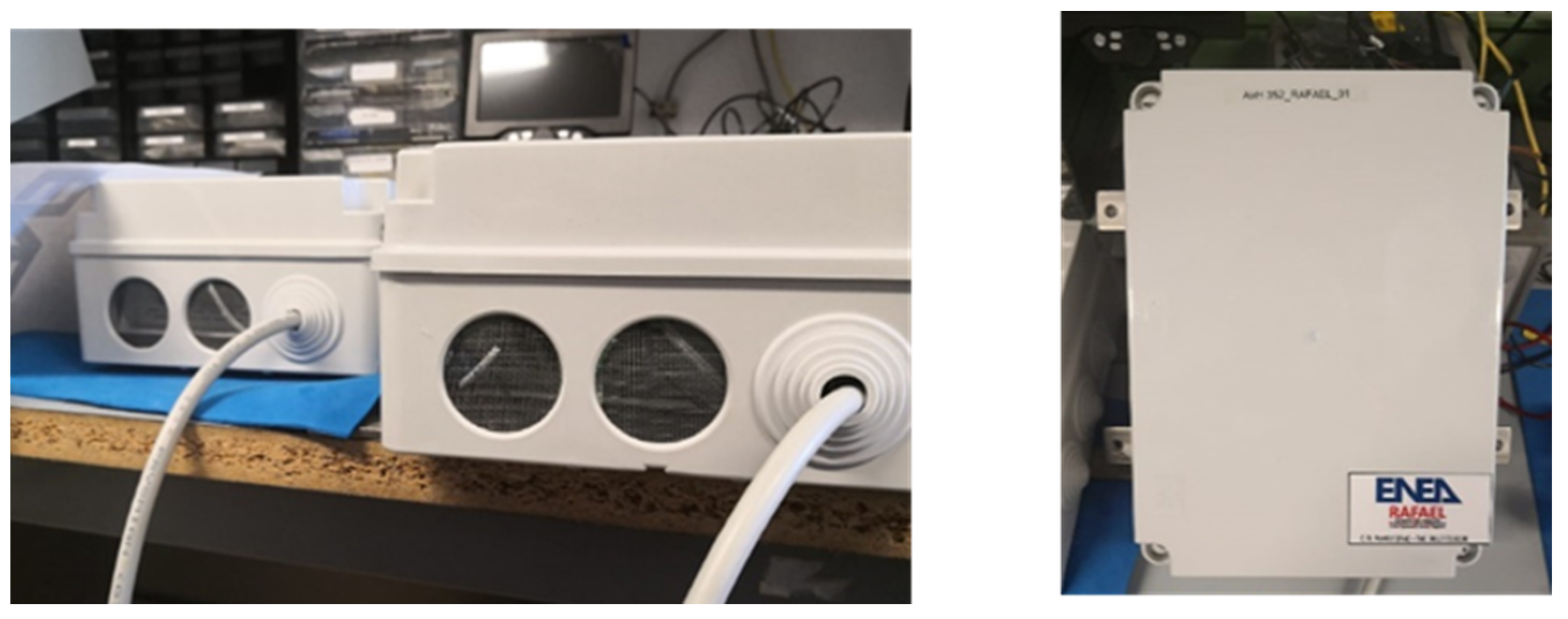
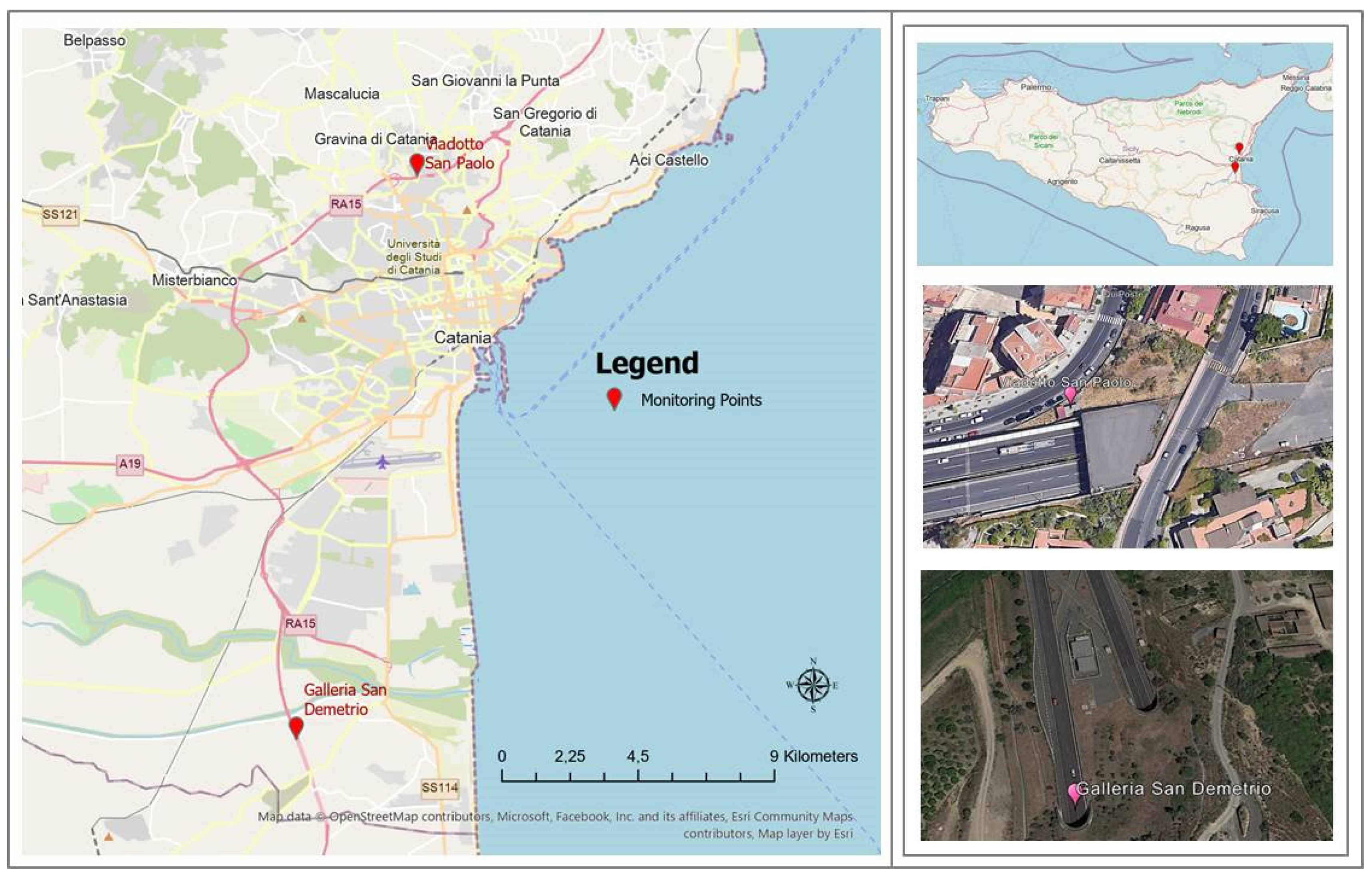
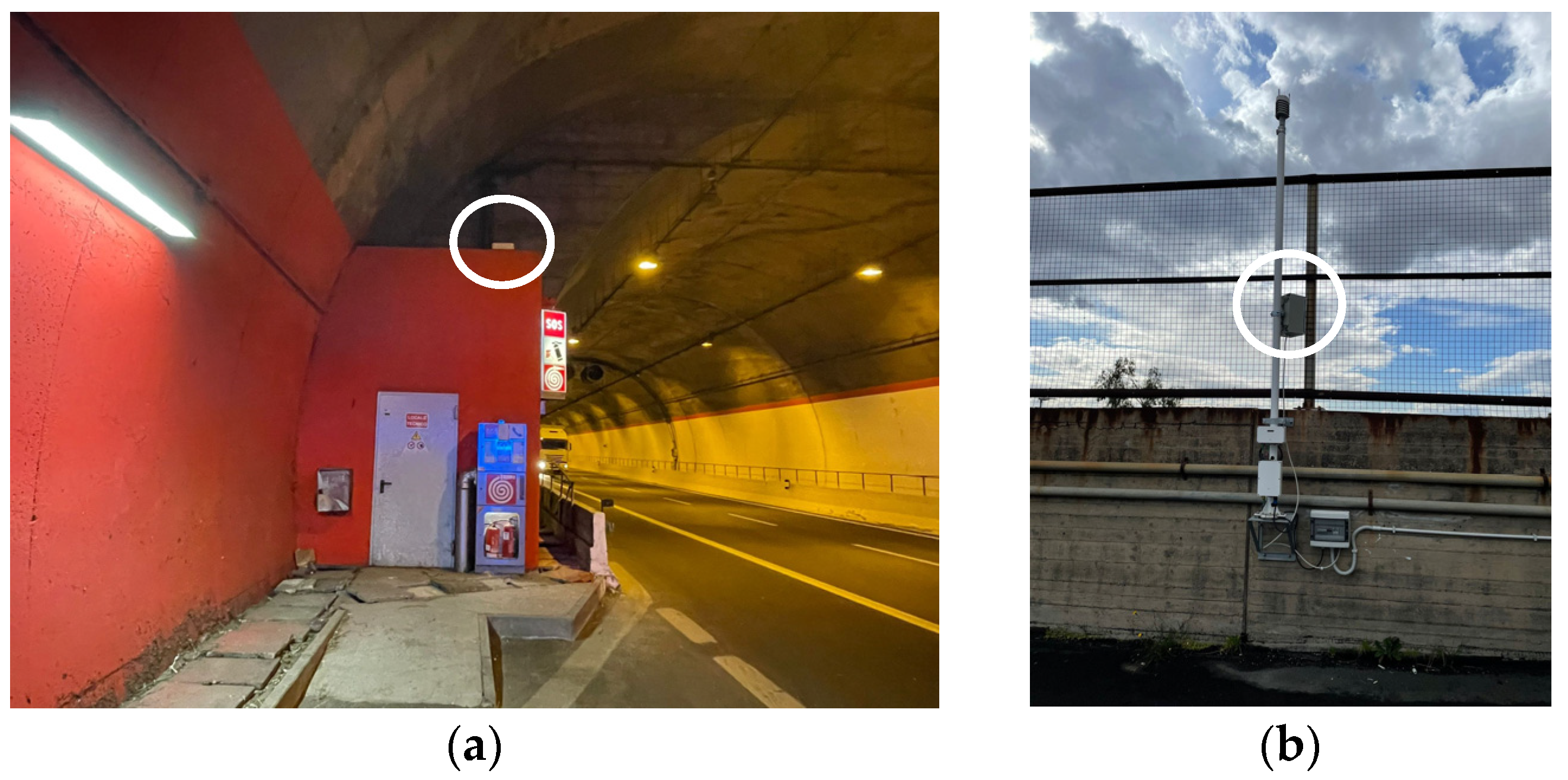
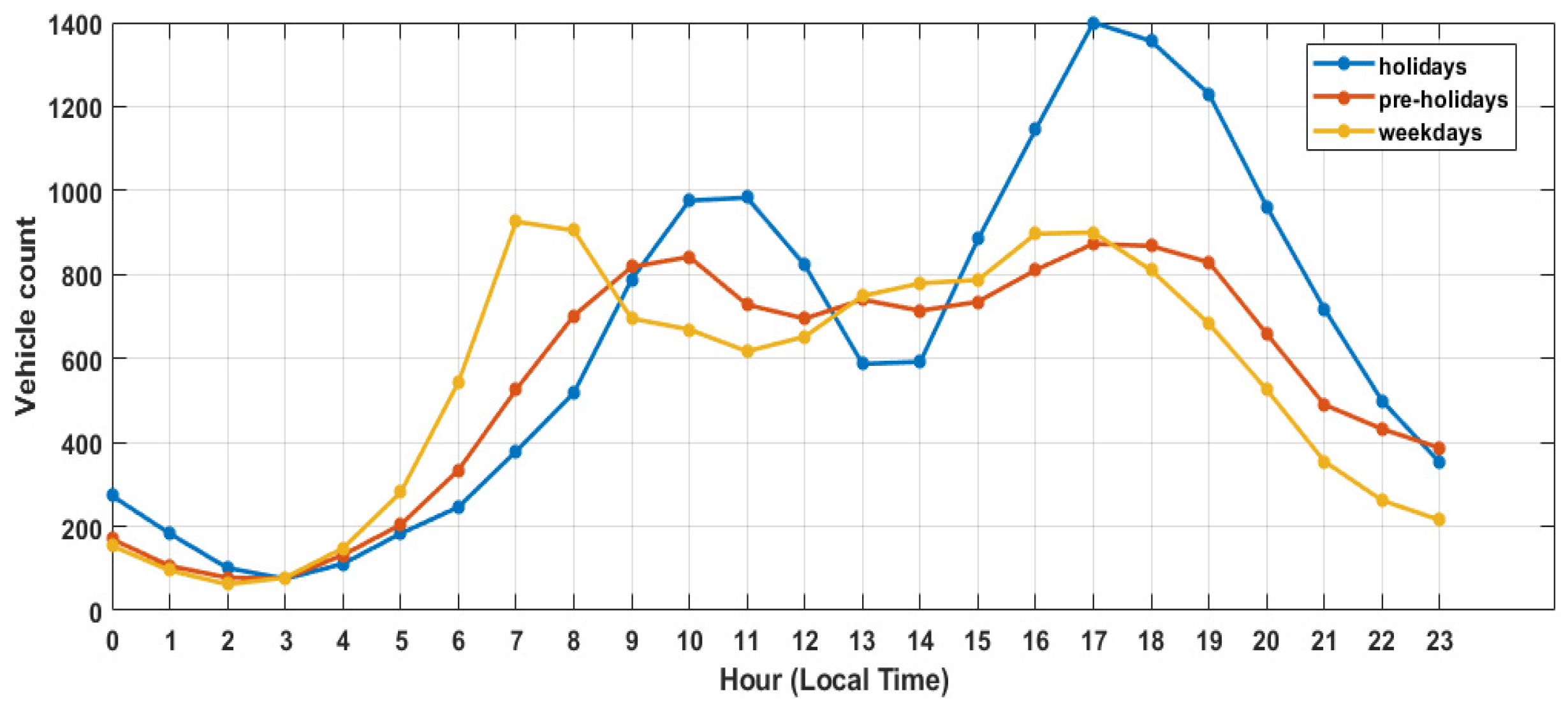
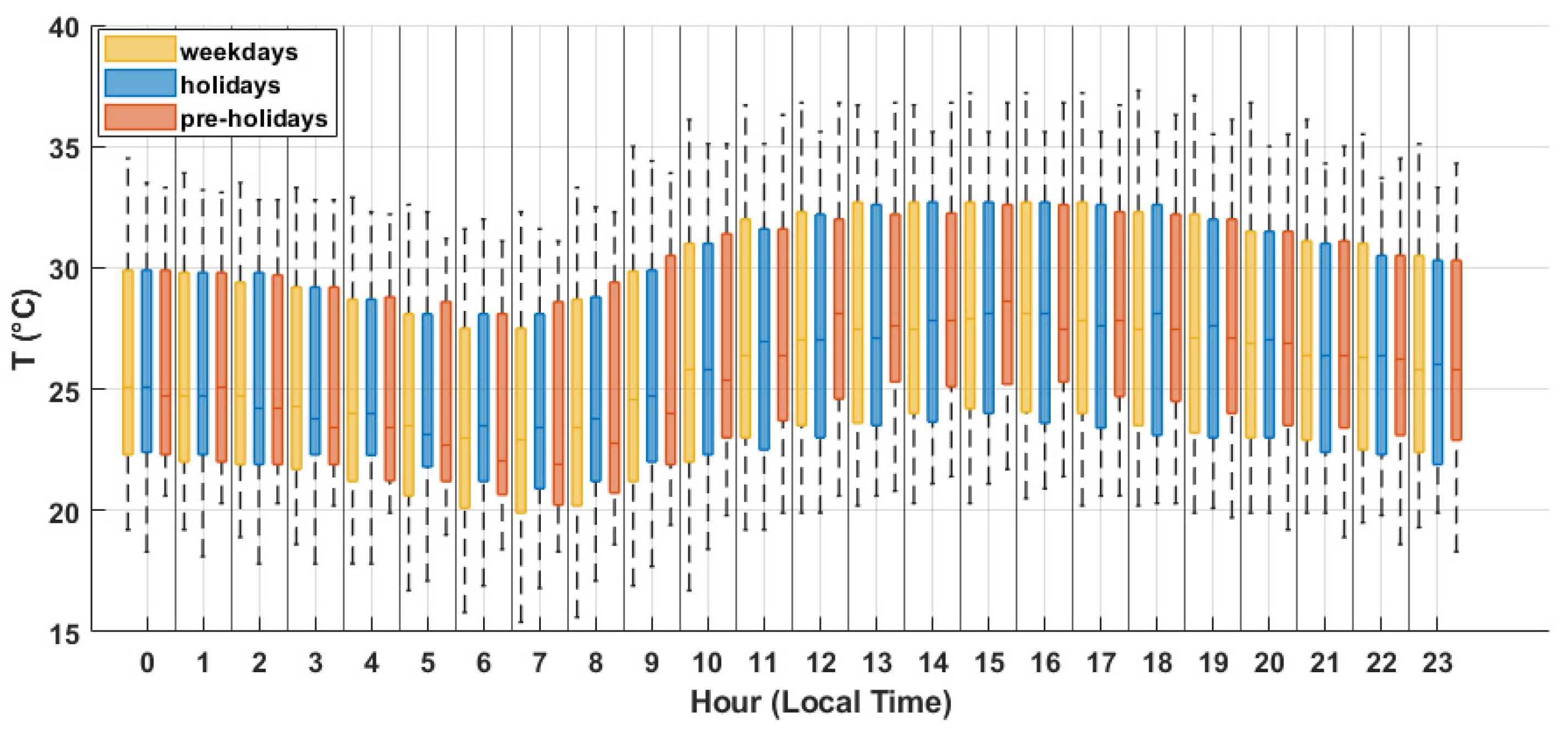
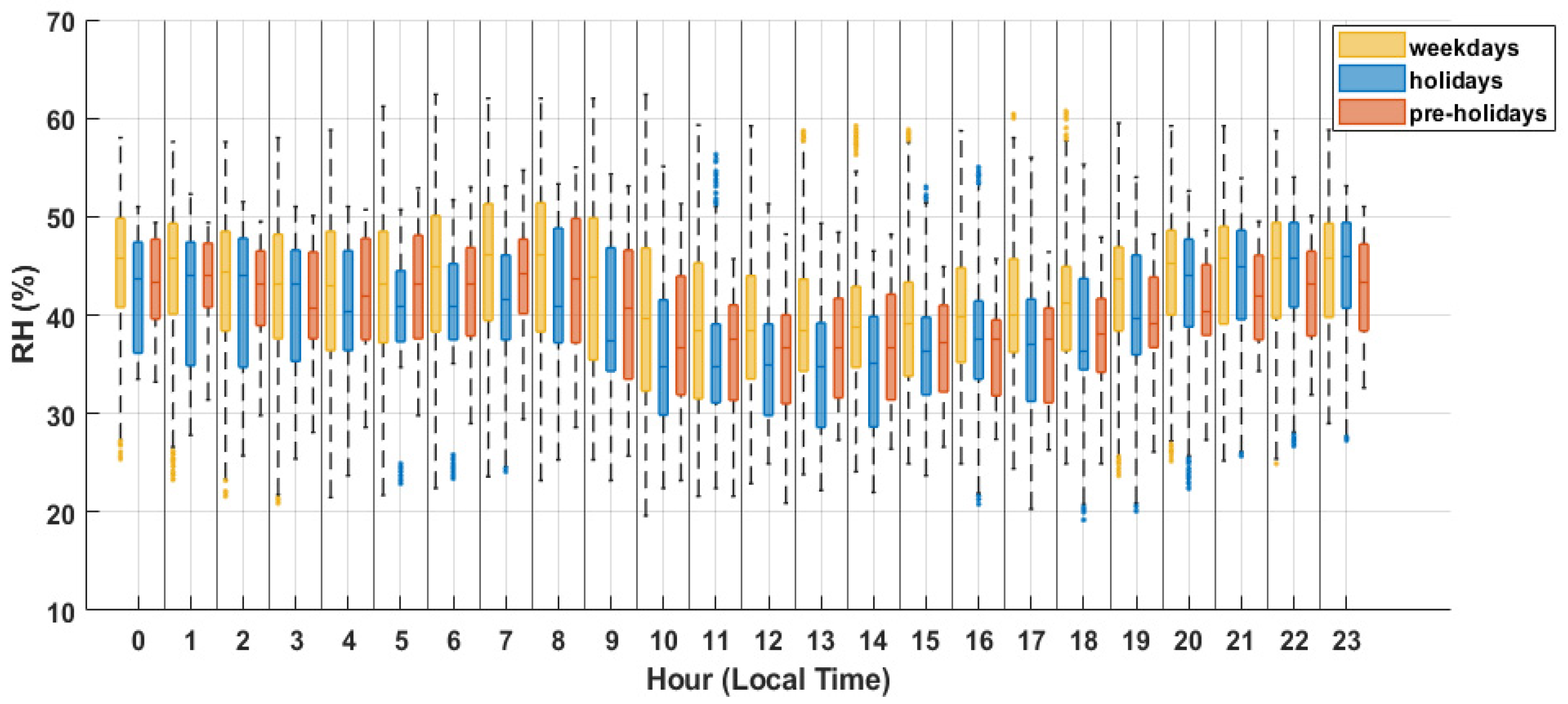
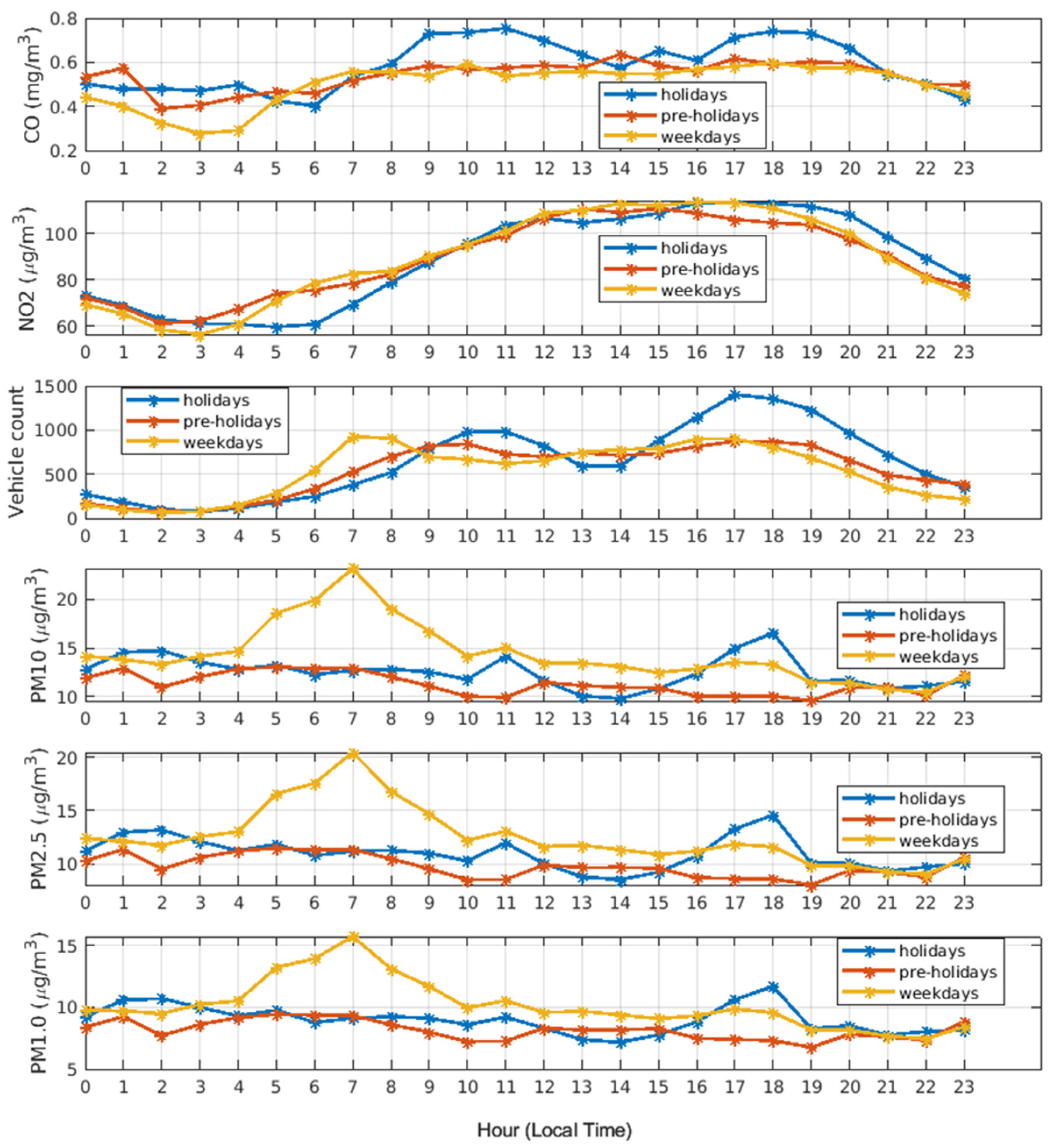
| MONICA Tunnel | MONICA Outside | ARPA Reference Station | |||
|---|---|---|---|---|---|
| Parameter | Range | Mean (std) | Range | Mean (std) | Mean (std) |
| T (°C) | (15–37) | 26 ± 5 | (11–48) | 29 ± 8 | 18 ± 3 |
| RH (%) | (19–62) | 42 ± 8 | (9–62) | 31 ± 11 | 69 ± 9 |
| MONICA Tunnel | MONICA Outside | ARPA Reference Station | |||
|---|---|---|---|---|---|
| Parameter | Range | Mean (std) | Range | Mean (std) | Mean (std) |
| CO (mg/m3) | (0–14) | 0.50 ± 0.35 | (0–1.8) | 0.38 ± 0.12 | 0.28 ± 0.1 |
| NO2 (µg/m3) | (27–291) | 89 ± 23 | (0–125) | 33 ± 18 | 23 ± 18 |
| O3 (µg/m3) | - | - | (0–166) | 51 ± 28 | 73 ± 25 |
| MONICA Tunnel | MONICA Outside | ARPA Reference Station | |||
|---|---|---|---|---|---|
| Parameter | Range | Mean (std) | Range | Mean (std) | Mean (std) |
| PM1 (µg/m3) | (0–200) | 10 ± 8 | (0–130) | 8 ± 5 | - |
| PM2.5 (µg/m3) | (0–312) | 12 ± 12 (18) | (0–185) | 10 ± 6 (15) | 12.5 ± 5 |
| PM10 (µg/m3) | (0–351) | 14 ± 13 (56) | (0–198) | 11 ± 7 (44) | 26 ± 17 |
| Vehicles Count (n°/Day) | Range | Mean (std) | |
|---|---|---|---|
| Road Tunnel San Demetrio | weekday | (62–926) | 500 ± 300 |
| pre-holiday | (76–873) | 550 ± 280 | |
| holiday | (75–1400) | 650 ± 400 | |
| Viaduct San Paolo | weekday | (135–3253) | 1700 ±1100 |
| pre-holiday | (179–2737) | 1400 ± 900 | |
| holiday | (170–2595) | 1300 ± 800 |
| Day of Week | Heavy-Duty Vehicles | Light-Duty Vehicles | Total Vehicles | |
|---|---|---|---|---|
| Road Tunnel San Demetrio | Monday | 2497 | 25,361 | 27,858 |
| Tuesday | 2838 | 23,530 | 26,368 | |
| Wednesday | 2959 | 24,106 | 27,065 | |
| Thursday | 2659 | 24,705 | 27,364 | |
| Friday | 2772 | 25,987 | 28,759 | |
| Saturday | 1676 | 25,197 | 26,873 | |
| Sunday | 608 | 30,009 | 30,617 | |
| Viaduct San Paolo | Monday | 4335 | 69,965 | 74,300 |
| Tuesday | 4948 | 72,000 | 76,948 | |
| Wednesday | 5050 | 72,328 | 77,378 | |
| Thursday | 4635 | 72,246 | 76,881 | |
| Friday | 4888 | 74,890 | 79,778 | |
| Saturday | 2788 | 63,433 | 66,221 | |
| Sunday | 1056 | 58,172 | 59,228 |
Disclaimer/Publisher’s Note: The statements, opinions and data contained in all publications are solely those of the individual author(s) and contributor(s) and not of MDPI and/or the editor(s). MDPI and/or the editor(s) disclaim responsibility for any injury to people or property resulting from any ideas, methods, instructions or products referred to in the content. |
© 2023 by the authors. Licensee MDPI, Basel, Switzerland. This article is an open access article distributed under the terms and conditions of the Creative Commons Attribution (CC BY) license (https://creativecommons.org/licenses/by/4.0/).
Share and Cite
De Vito, S.; Del Giudice, A.; D’Elia, G.; Esposito, E.; Fattoruso, G.; Ferlito, S.; Formisano, F.; Loffredo, G.; Massera, E.; Bellucci, P.; et al. Correlating Air Pollution Concentrations and Vehicular Emissions in an Italian Roadway Tunnel by Means of Low Cost Sensors. Atmosphere 2023, 14, 679. https://doi.org/10.3390/atmos14040679
De Vito S, Del Giudice A, D’Elia G, Esposito E, Fattoruso G, Ferlito S, Formisano F, Loffredo G, Massera E, Bellucci P, et al. Correlating Air Pollution Concentrations and Vehicular Emissions in an Italian Roadway Tunnel by Means of Low Cost Sensors. Atmosphere. 2023; 14(4):679. https://doi.org/10.3390/atmos14040679
Chicago/Turabian StyleDe Vito, Saverio, Antonio Del Giudice, Gerardo D’Elia, Elena Esposito, Grazia Fattoruso, Sergio Ferlito, Fabrizio Formisano, Giuseppe Loffredo, Ettore Massera, Patrizia Bellucci, and et al. 2023. "Correlating Air Pollution Concentrations and Vehicular Emissions in an Italian Roadway Tunnel by Means of Low Cost Sensors" Atmosphere 14, no. 4: 679. https://doi.org/10.3390/atmos14040679
APA StyleDe Vito, S., Del Giudice, A., D’Elia, G., Esposito, E., Fattoruso, G., Ferlito, S., Formisano, F., Loffredo, G., Massera, E., Bellucci, P., Ciarallo, F., & Di Francia, G. (2023). Correlating Air Pollution Concentrations and Vehicular Emissions in an Italian Roadway Tunnel by Means of Low Cost Sensors. Atmosphere, 14(4), 679. https://doi.org/10.3390/atmos14040679










